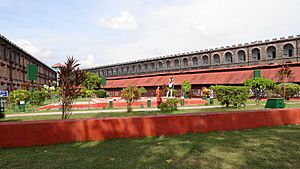Cellular Jail facts for kids
The Cellular Jail, also known as Kālā Pānī (Hindi for black waters), was a prison built by the British in the Andaman and Nicobar Islands, India. This prison was used to send political prisoners far away to this remote group of islands. Many important leaders, like Batukeshwar Dutt, Yogendra Shukla, and Vinayak Damodar Savarkar, were held here during the fight for India's freedom. Today, the prison complex is an important national memorial.
Contents
Building the Cellular Jail
The construction of the prison started in 1896 and finished in 1906. The original building was made of reddish-brown bricks. These bricks were brought all the way from Burma. When it was completed, the jail had seven wings, each with three stories. There were no large rooms for many prisoners; instead, it had 696 single cells. Each cell was about 4.5 by 2.7 meters in size, with a small window for air located about 3 meters high.
Why it was Called Cellular Jail
The name "Cellular Jail" came from its design. Each cell was built for one person, stopping prisoners from talking to each other. Also, the wings were built like spokes of a wheel. This way, a prisoner in one cell could only see the back of cells in another wing. This design made it impossible for prisoners to communicate.
Cellular Jail During World War II
In 1942, the Empire of Japan took over the Andaman Islands from the British. The Cellular Jail then became a prison for British captives. During this time, Subhas Chandra Bose, a famous Indian leader, also visited the island. In 1945, when World War II ended, the British took control of the islands again.
Cellular Jail After India's Freedom
After India became independent, two wings of the jail were torn down. However, many former prisoners and political leaders protested this. They felt it was like trying to hide the bad treatment they had faced. Because of these protests, the remaining three wings and the central tower were saved. On February 11, 1979, the then Prime Minister of India, Shri Morarji Desai, officially made it a National Memorial.
A Hospital for the Community
In 1963, the Govind Ballabh Pant Hospital was built on the grounds of the Cellular Jail. Today, it is a large hospital with 500 beds and about 40 doctors. It serves the people living in the area. The 100th anniversary of the jail's completion was celebrated on March 10, 2006.
Images for kids
















